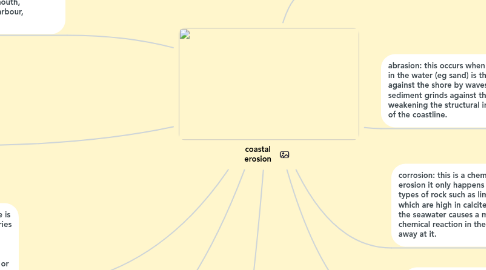coastal erosion
by Michael Ford

1. attrition: continued wave action hurls stones and other material at the land, which smooths and breaks up rocks on the coast, dislodging them. These in turn collide with other rocks on the shore.
2. destructive waves: they are created from big strong waves when the wind is powerful and for a long period time. they occur when wave energy is high and the wave has travelled for a long period of time.
3. constructive waves: each wave is low as the wave breaks, it carries material up the beach in its swash. the beach material will then be deposited as the backwash soaks into the sand or slowly drains away.
4. prevailing wind: prevailing wind is the ordinary wind direction and it also carries strong waves to the shore and crashes the waves against the rocks.
5. Estuary: The tidal mouth of a large river where the tide meets the stream. some estuary's, the thymes, river Humber, Exmouth, Chichester harbour, Aberdovey.
6. hydraulic action: wave action compresses air in the rock which eventually causes a crack and then over the years a cave and so on.
7. corrosion: this is a chemical based erosion it only happens with certain types of rock such as limestone or chalk, which are high in calcite. the acidity of the seawater causes a mineral causes a chemical reaction in the mineral eating away at it.
8. abrasion: this occurs when sediment in the water (eg sand) is thrown against the shore by waves the sediment grinds against the land, weakening the structural integrity of the coastline.
9. salt marsh: salt marshes occur on low-energy shorelines in temperate and high latitudes which can be stable, emerging, submerging depending if the sedimentation was greater, equal, or lower than relative sea level rise respectively.


